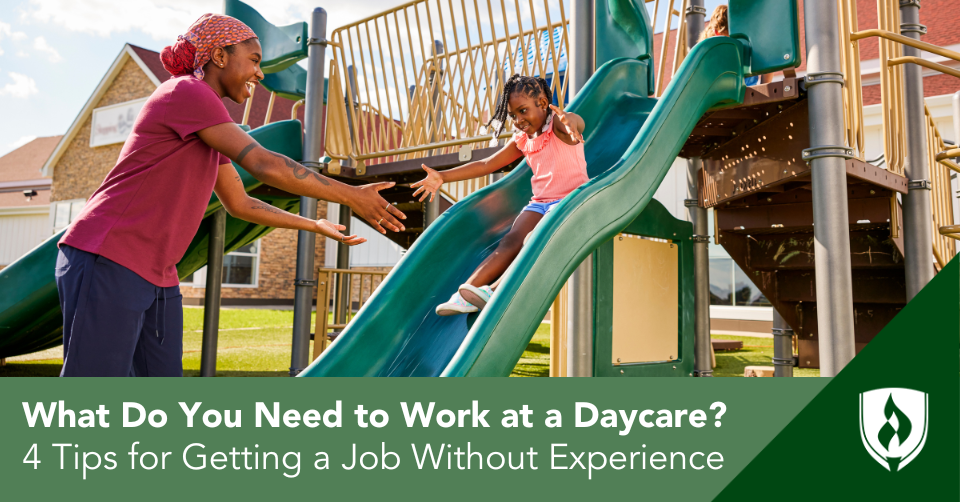What Do You Need to Work at a Daycare? 4 Tips for Getting a Job Without Experience
By Hope Rothenberg on 08/15/2023

You love kids and enjoy spending time with the ones in your life. You appreciate their unending curiosity, boundless energy and humor. Plus, being around them just gives you joy.
You’d love working with little kids, and maybe you’ve even done some babysitting in the past. But you’ve never had any formal experience in a childcare setting—and you’d like to change that. You want a career working with children, and with your patience and creativity, you know you’ll make a difference in their young lives.
Don’t let your lack of experience stop you!
Everyone has to start somewhere. Keep reading for expert advice on everything you need to know about how to get a job at a daycare with little or no experience.
How to get a job at a daycare
Early childhood employers run the gamut from places that only want to keep kids safe and fed, to places that build in nurturing experiences or developmentally-appropriate curriculum. And it can be hard to know what you are signing up for before you apply.
For starters, what’s the difference between childcare, daycare and preschool? These terms get thrown around almost interchangeably, but they aren’t the same. First, make sure you know which environment you want. Check out our article Childcare vs. Daycare: What’s the Difference? (And Why It Matters) for more on that.
1. Earn an ECE certificate
Childcare centers and preschools have their own requirements for applicants, ranging from certifications to degrees. Childcare workers at the national level typically need a high school diploma or equivalent, according to the Bureau of Labor Statistics.2
To get a daycare job without experience, it will help to pair your high school diploma with an Early Childhood Education (ECE) certificate.
Additionally, you may want to consider pursuing a professional certification like the Child Development Associate (CDA®) credential from the Council for Professional Recognition.
These programs are not typically a huge time investment. For example, the ECE Certificate program at Rasmussen University can be completed in as few as 12 months.1
Earning an ECE certificate can show your dedication to employers and help you stand out from the pack.
It will also help you navigate some of the challenges that come with working with young children. Frustrated parents, a defiant preschooler or a colleague who isn’t pulling their weight can make the work harder than it needs to be—practical ECE training goes a long way to help you respond in these situations.
Completing a certificate program can also expand the opportunities you qualify for since high quality early childhood centers look for applicants who show initiative.2
“We are always looking to see candidates who seek professional development on their own,” says Jennifer Thompson, chief operating officer at Global Pioneer Academy. “Know your state networking and training programs. Attend free trainings and talk to directors and owners.”
Daycare workers and childcare professionals may need to provide vaccination records and pass a background check before getting started. You may also need first aid and CPR training.
2. Present yourself as a lifelong learner
You may not have decades of experience as a childcare worker, but your ability to learn on the job can be a huge asset. If you can demonstrate that you are an adaptable professional who keeps learning as they go, you will help instill confidence in prospective employers.
“We often hire individuals without experience who are committed to the industry and learning,” says Thompson. Following childcare and education blogs is a fun and easy way to stay informed on industry happenings.
Any initiative you demonstrate, whether related to professional development, the industry or experience with children, helps you stand out for potential employers to see.
It’s also worth asking a potential employer about the training opportunities they have. Some childcare centers offer free training to their employees and help pay their tuition if they decide to pursue connected early childhood education programs.
3. Volunteer and showcase your volunteer work
One way to get a job at a daycare without previous experience, is to get a bit of experience. It doesn’t matter if you get paid or not, volunteer experience still counts.
“Never underestimate the importance of doing volunteer work,” says Joyce Monfort, assistant professor for the Rasmussen University School of Education. “Volunteer positions show employers you are dependable, can work with others and can maintain a position over a period of time.”
Offer to babysit in your community. This will allow you to work with children across a range of ages to see which age you’d most enjoy working with. After all, there’s a big difference between two-year-olds and five-year-olds.
You could also volunteer with children at an after-school program, a summer camp or as a tutor.
Another option is to reach out to local churches in order who have children’s ministries or Sunday school programs. You could also coach a sports team, volunteer in a nonprofit that serves children or volunteer preparing meals at women's shelters. Experiences like these show employers that you’re capable of working with children.
“Any volunteer opportunities you pursue demonstrate to a prospective employer that you are willing to help give back to your community. If the volunteer experience is in the early childhood field, it can even often lead to a paid position in the future,” Monfort says.
4. Showcase your relevant skills and qualities
“Don’t overlook what previous experiences you may already have that would make you employable,” says Monfort.
The key here, she stresses, is your ability to demonstrate verbal, written and technology skills you may possess. These transferable skills are highly-valued by employers who are usually willing to help train you in technical skills of the job.
The way to do this is to showcase a strong set of applicable skills on your childcare resume and personal qualities in your cover letter.
Also consider how courses you’ve taken or other jobs you’ve had may have prepared you for work in a daycare. Include these things on your resume and be prepared to explain how those experiences gave you skills that matter in ECE.
Important skills in early childhood education are good things to highlight on your application where you can. Some of these valuable soft skills for an ECE career are:
- Problem-solving
- Reliability
- Love of learning
- A good sense of humor (okay, that one is more of a personality trait, but it helps!)
Another in-demand childcare skill is communication, according to the Bureau of Labor Statistics (BLS).2 Teachers must clearly communicate with young students, both one-on-one and when leading large groups. They also need to understand parental concerns and be able to provide clear feedback on progress, behavior and expectations.
In general, strong interpersonal skills are invaluable when working in childcare centers.
Think about the ways in which you’ve already had to be a great communicator in your life so far. Be sure to highlight those experiences in your cover letter and resume when applying to childcare facilities and be prepared to elaborate on them during an interview.
Don’t forget to highlight your creativity--since it’s a huge boost. You’ll be working with many children of different learning preferences, so being able to exercise innovative teaching strategies through play and activity is an asset.
Start your childcare career with what you’ve got
You don’t need a jam-packed resume full of childcare experience to get a job at a daycare. A little strategic placement of your skills and coursework combined with a certification program can help you stand out from the crowd—and approach the little ones with a deeper understanding of how to help them grow.
You may begin as a daycare worker or teacher, but you could progress to overseeing multiple classrooms, becoming a childcare director or even opening your own childcare center.
So what are you waiting for? It’s time to exchange the job you tolerate for a childcare career you love. Check out our article, “What Can I Do With an Early Childhood Education Degree?” to learn more about where you could go from here.
Rasmussen University reserves the right to accept or deny credits according to policies outlined in the course catalog. Actual time to completion will be based upon transfer evaluation and eligibility. Check out how to craft a childcare resume to give you the tools to help land your next job.
1Bureau of Labor Statistics, U.S. Department of Labor, Occupational Outlook Handbook, [career information accessed July 2023] Information represents national, averaged data for the occupations listed and includes workers at all levels of education and experience. This data does not represent starting salaries, and employment conditions in your area may vary.
2Completion time is dependent on transfer credits accepted and the number of courses completed each term
3Graduates of Early childhood Education programs at Rasmussen College are not eligible for licensure as a teacher in an elementary or secondary school. A Bachelor’s degree and a state teaching license are typically required to work as a teacher in a public school and some private school settings. States, municipalities, districts, or individual schools may have more stringent licensing requirements. Students must determine the licensure requirements in the state and school in which they intend to work. Child care facilities and the states in which they are located establish qualifications for staff that work with children, and often implement guidelines regarding age, education, experience, and professional development. Students must determine the licensure requirements in the state and facility in which they intend to work.
EDITOR'S NOTE: While the term “daycare” is commonly used, many early childhood educators prefer to use other terms to better reflect the professionalism of the field. Our article, “Childcare vs. Daycare: What’s the Difference? (And Why It Matters),” explains this in further detail.
This article was originally published in 2018. It has since been updated to include information relevant to 2023.




